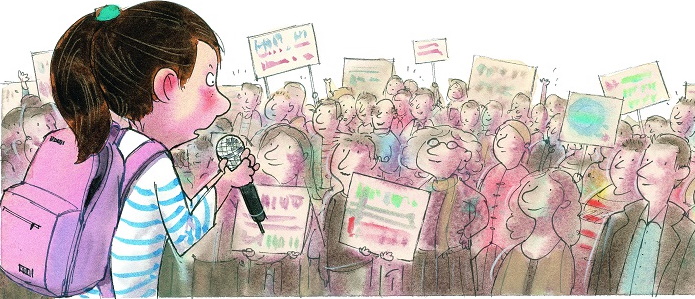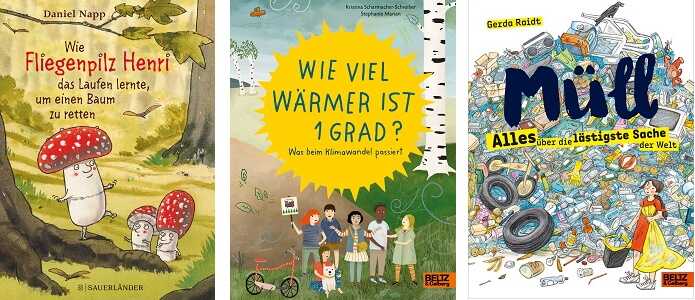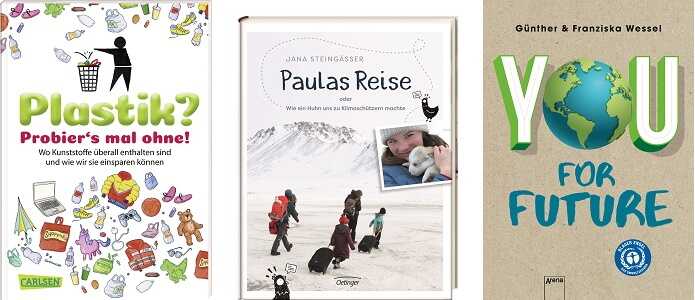Bookworld
Ecology & Sustainability in Recently Published Children's Books

Join in and protect nature!
In addition to Peter Wohlleben’s bestsellers for adults, he has written engaging books about forests and nature for children such as, „Hörst Du, wie die Bäume sprechen?“ (“Can you hear the trees talking?”) and „Weißt Du, wo die Tiere wohnen?“ (“Do you know where the animals live?”) that have inspired young people around the world. Since his success, several new children’s books focusing on environmental protection and the effects of climate change have been recently published. Stories to read aloud, handy non-fiction books for the classroom, or a book for young people that was written by a young climate activist, who talks about how her life has changed, while offering practical tips to interested young people.
As the creator of the bear picture book series, “Dr. Brumm”, Daniel Napp has gathered a huge fan following over the years. But the illustrator from Münster not only is a magnificent draughtsman, he also has proven to be a sensitive and fascinating author whose stories resonate with children who are slightly older as well. His most recent book, „Wie Fliegenpilz Henri das Laufen lernte, um einen Baum zu retten” (“How the toadstool Henri learned to save a tree”) (2020) entertainingly deals with a very important subject. Napp recalls: “A few years ago, two very old plantain trees were about to be felled in Münster to make room for a new shopping center.” Thanks to their relentless campaigning, Nina and the toadstool managed to save a tree that almost had suffered the very same fate. The book’s lively dialogue inspires children to eagerly join in the excitement, while demonstrating how important such a rescue mission can be.

Non-fiction
Kristina Scharmacher-Schreiber’s intent is to motivate children to help save the environment. She clearly succeeds in her goal. Her non-fiction book is well-grounded and easy to understand, especially with her vividly drawn illustrations and infographics. „Wie viel wärmer ist 1 Grad? Was beim Klimawandel passiert“ (“How much warmer is 1 degree? What does climate change mean?”) (2019) has been awarded the EMYS Non-Fiction Book Prize 2019. “I wanted to draw a realistic picture of the situation without frightening children away. That’s not so easy when you look at the extent to which climate change already has affected the entire world,” the author said. In order to make a contribution to environmental protection, the author made sure the book was produced with 100% recycled paper, without a plastic protective cover and printed with mineral oil-free printing inks.
When the Leipzig-based illustrator and author Gerda Raidt came up with the idea for “Müll - Alles über die lästigste Sache der Welt” (“Garbage: everything you need to know about the nastiest thing in the world”) (2019), she had the impression there were not enough books dealing with the environment. “At the same time, a children's book makes it easier to engage in a conversation about it. Moreover, children are usually more willing to change than older people and can more easily bring a new impetus to changing habitual behavior. Young people will not only learn a great deal about today’s garbage problem, they also are offered insights into its historical dimension, how other countries deal with the situation, and how they can become active themselves – and if they follow a few simple suggestions, they won’t have to take the garbage out every day.
The practical non-fiction book “Plastik? Probier´s mal ohne! Worin Kunststoffe enthalten sind und wie wir sie einsparen können“ (2019) by Dela Kienle. (Plastic? Try not to use it! What things are made of plastic and what we can do to avoid it.). As a result of her research, Kienle also gradually changed quite a few things in her life. “Many children want to do something for the environment, and there are few areas in which they can as easily succeed, as they can with plastics,” says Kienle. In addition to the horrifying statistic that every German produces an average of 37 kilograms of plastic waste, she also offers her readers 30 very practical tips for avoiding the use of plastics.

Photo Book
Jana Steingässer believes that everybody should define what they believe they can easibly achieve to protect the environment. The journalist, along with her family of six, set out on a journey of discovery and, together with her husband, the photographer Jens Steingässer, published a fantastic travelogue entitled: Paulas Reise oder Wie ein Huhn uns zu Klimaschützern gemacht hat.“ (2019) (“Paula's Journey or How a Chicken Made Us into Climate Activists”) Greenland, the Alps, South Africa and Albania. The faraway and very different countries intrigue their daughter Paula, but at the same time she often also sees the serious consequences of climate change and the damage it has inflicted on different parts of the world. As a result of her travels, she decides to become a climate activist once she returns to Germany.
Book for Young Adults
In 2019, Franziska Wessel also decided to become a climate activist. Thanks to her book: “You for future” (2020) – written jointly with her father Günther Wessel – other young people will also benefit from her knowledge and valuable experience. “I hope that the utopia of a climate friendly world will one day become reality, that there will be a decrease in inequality and democracy will grow stronger,” said Wessel. Franziska Wessel's book can be described as clearly structured, with an appealing layout and very interesting reports on the 16-year-old student's experiences, along with informed excursions into sociology and philosophy. Moreover, she offers her readers practical tips on how to set up a campaign and organize a demonstration.
If you are looking for even more children's book tips about “Climate, Environment and Nature”, the Deutsche Akademie für Kinder- und Jugendliteratur offers a monthly book tip, good advice and is always up to date.
https://www.akademie-kjl.de/buch-app-empfehlungen/klima-umwelt-natur-buchtipp/
Antje Ehmann works as a freelance journalist, juror and lecturer on children's books and literature for young people.
Translated by Zaia Alexander